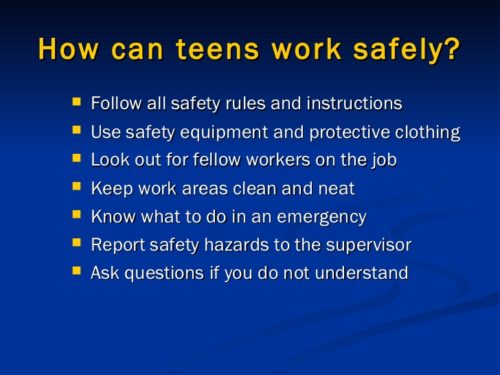In terms of raw numbers, retail establishments, restaurants, and grocery stores are three of the largest employers of teen workers. While not a “most dangerous” job for teens, these workplaces can be dangerous.
According to 2009 data from the Centers for Disease Control and Prevention (CDC), 44 percent of 15- to 17-year-olds work in the “leisure/hospitality” sector, mostly in restaurants and other food service. Nearly one in four (24 percent) work in retail jobs. Not surprisingly, a lot of teen occupational injuries occur in those two sectors. Nationally, nearly half of teenagers injured on the job work in restaurants or other “leisure/hospitality” companies. Three in 10 work in retail establishments.
The Massachusetts teen worker survey mentioned previously found similar results: among the accommodation and food service sector and the retail trade sector accounted for 58 percent of the workers’ compensation lost wages claims because of injuries.
In a 2007 article in Pediatrics by Carol Runyan, et al., based on a phone survey of 14- to 18-year-olds employed in the retail and service sectors found that “despite federal regulations prohibiting teens under 18 from using certain types of dangerous equipment (e.g., slicers, dough mixers, box crushers, paper balers) or serving or selling alcohol in places where it is consumed, 52 percent of males and 43 percent of females reported having performed [more than one] prohibited task.”
Many teens work in restaurants are at risk of burns and other kitchen-related injuries. In some states, restaurants rank first in the number of youth work injuries, although the injuries are often less severe than in many of the occupations cited in this report. Fryers, meat slicers, knives, compactors, and wet, greasy floors can all combine to form a dangerous work environment.
At times, teenagers work in what is typically a safe environment but perform unsafe tasks. For example, grocery stores employ a lot of teen workers and, for the most part, they provide a safe work environment. However, when workers are rushing or are improperly trained, accidents can happen.
Workers under 18 are allowed to load trash compactors—found in most grocery stores—but they are prohibited from operating them because of a number of gruesome accidents that have occurred to users in the past. Safety specialists worry that improperly trained youth will not obey the law. Similarly, minors—unless they are working in agriculture–are not allowed to drive a forklift, but young people will sometimes get behind the wheel anyway.
In 2009, a woman, barely 18, working in a grocery in Indiana, lost her hand trying to clean a grinder in a grocery store.
Retail stores may seem like a safe environment, but teens can get hurt lifting boxes, cutting boxes open, crushing boxes, and falling from ladders.
Mall and grocery parking lots are often the site of car accidents and can also be dangerous for young workers.
Nearly all workplaces hold some danger. NCL’s goal is not to instill teen workers with fear but to get them and employers to minimize the risks involved with some jobs by recognizing known hazards.



